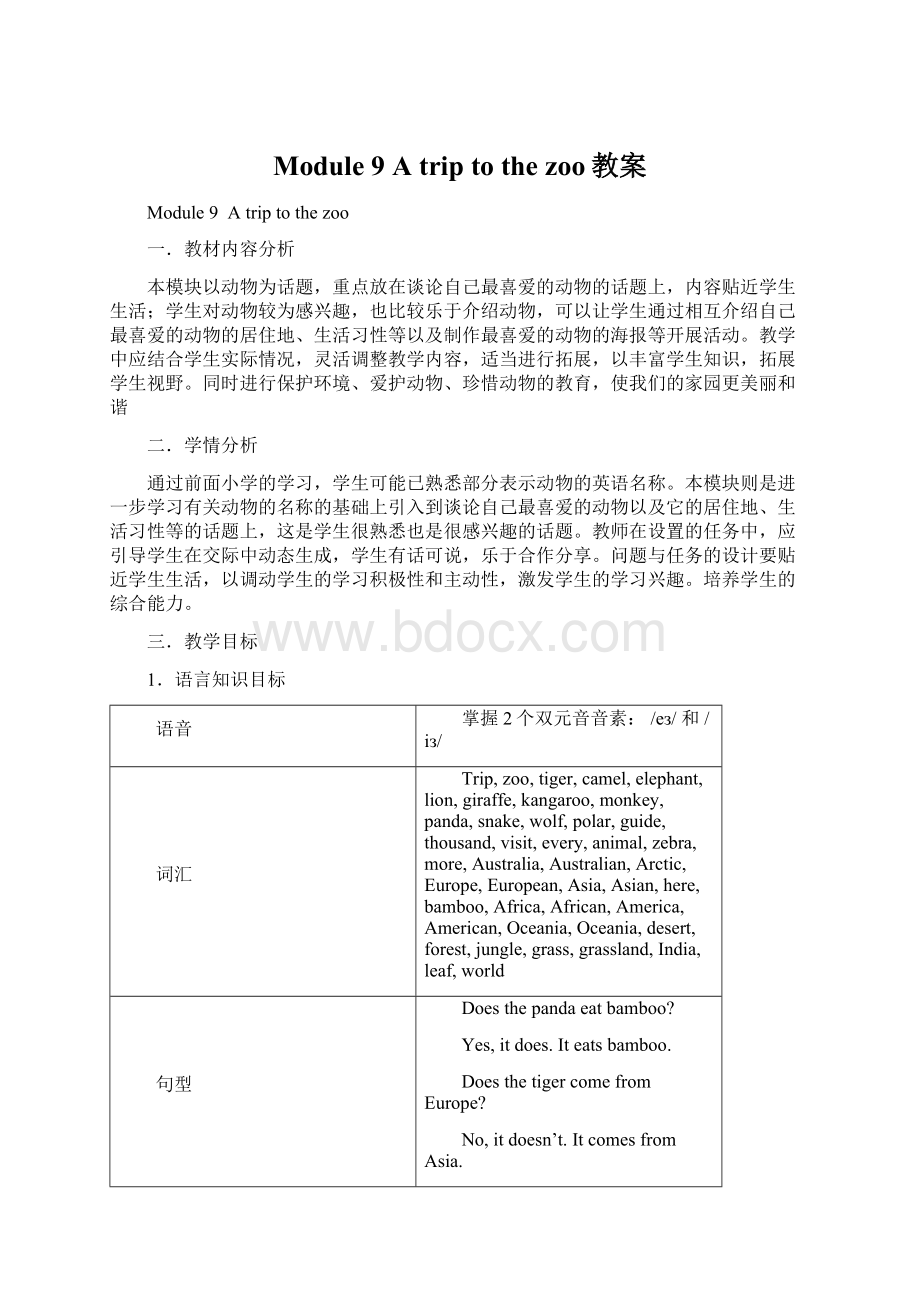Module 9 A trip to the zoo教案Word格式文档下载.docx
《Module 9 A trip to the zoo教案Word格式文档下载.docx》由会员分享,可在线阅读,更多相关《Module 9 A trip to the zoo教案Word格式文档下载.docx(12页珍藏版)》请在冰豆网上搜索。

功能
介绍制作自己最喜爱的动物海报。
话题
以动物中心,以介绍自己喜爱的动物、以及它的居住地和生活习性为话题。
2.语言技能目标
听
能听懂有关介绍动物的对话和短文,提高学生实际应用能力。
说
能利用一般现在时(主语为第三人称单数)的一般疑问句的句型询问或回答同伴有关动物的问题;
流利地说出本模块的生词、短语。
读
能阅读包含一般现在时的有关动物介绍的简单文章。
进行简单的阅读技能训练。
写
1.能用一般现在时(主语为第三人称单数)的句型写出简短的介绍自己最喜爱的动物的短文;
2.能正确使用大小写形式介绍某个地方。
3.能用所学词汇制作动物海报。
演示与表达
利用绘画或摄影的图片,制作自己最喜爱的动物的海报,并向全班展示和说明。
3.学习策略目标
帮助学生在英语学习中了解自我,推销自我。
注重合作学习,学会与人合作,培养学生相互沟通和交往的能力。
利用学会的语言知识去挖掘自己内在的潜能。
引导学生利用网络资源获取有关动物的信息。
4.文化意识目标:
了解中国的野生动物和世界各地的野生动物的习性和生长状况。
使学生进一步明确保护环境,爱护动物的重要性。
5.情感态度目标
通过学习让学生领悟到大自然不仅有人类的存在,而且还要使生养我们的这个地球平衡发展,保护和珍惜野生动物,使我们的家园更美丽和谐。
四.重点难点
1.教学重点
(1)重点句型:
一般现在时(主语第三人称单数)的一般疑问句以及肯定和否定形式。
(2)重点话题:
Talkaboutone’sfavouriteanimal.
2.教学难点
(1)有关动物的名词及它们在句中的正确运用。
(2)掌握一般现在时(主语第三人称单数)的一般疑问句以及肯定和否定形式。
(3)能用恰当地道的英语问答有关动物的问题以及介绍自己的最喜爱的动物。
3.突破途径
以话题为核心,通过个人思考、小组及班级活动等不同途径,在听、说、读、写中使单词及句型以不同的形式反复出现,在足够的输入中,达成有效的语言输出。
五、课时安排
为了能较好地实现既定的教学目标,结合本模块教学内容和学生的学习规律,将本模块定为三课时。
具体安排如下:
第一课时:
Vocabulary,listeningandspeaking
第二课时:
Vocabulary,readingandwriting
第三课时:
PronunciationandLanguageinuse
六.教学设计
Vocabulary,listeningandspeaking
TeachingAimsandDemands:
1.LanguageKnowledge
Keyvocabulary:
trip,zoo,tiger,camel,elephant,lion,giraffe,monkeykangaroo,panda,snake,wolf,polar,guide,thousand,visit,every,animal,zebra,more,Australia,Arctic,Europe,Asia,here,bamboo.
Keystructure:
Doesthepandaeatbamboo?
Yes,itdoes.
DoesthetigercomefromEurope?
No,itdoesn’t.
2.Listeningskill:
Tounderstandconversationsaboutaskingandansweringquestionsaboutanimals.Improvethestudents’listeningability.
3.Speakingskill:
Askandanswerquestionsaboutanimals.Improvethestudents’speakingability
4.TeachingAids:
Multi-Media(orTaperecorder,OHP)
TeachingProcedures:
Step1Warmingup
1.Sswatchaclipofthevideoaboutanimals:
TomandJerry.
2.Haveabrainstorming:
Doyoulikeanimals?
Whichanimalsdoyouknow?
设计意图:
看一段录像引出:
Doyoulikeanimals?
Whichanimalsdoyouknow?
通过谈论自己喜欢的动物,引入今天要学习的新词汇。
此步激发了学生对动物的兴趣,为引入新课做好了铺垫。
Step2Newwordslearning
1.Playaguessinggame.ShowtheSsthepicturesofanimalsonebyone,bycoveringapartofeachone.Askthemtoguesswhatitisandtrytodescribeit.
eg.1)T:
It’sthekingoftheforest.It’sscared.
Ss:
It’satiger.
2)T:
Yes,it’sapanda.Canyoudescribeit?
Yes,it’sblackandwhite.Ithastwoblackeyes.Itlookslikeabear.
2.Haveamemorychallenge:
Whichismissing?
根据出示的动物身上一小部分及句子的提示,让学生猜是什么动物,并引导他们用英语描述此动物。
可以使学生自己已有的认知水平和实际应用结合起来,这会给他们带来成就感。
然后通过记忆游戏:
让学生在学完新单词后,记忆哪只动物不见了,既巩固了所学单词,又调动了学生的参与性和主动性,使学习兴奋点持续下去。
Step3Lookingandlearning
1.ShowapictureofapolarbearandapictureofapenguinandasktheSs:
1)Whatarethey?
2)Wheredotheylive?
Doyouknow?
2.ThenshowthepictureoftheNorthpoleandtheSouthpole.HelptheSstoask:
DoesthepolarbearliveintheNorthPole?
Yes,itdoes.
DoesthepenguinliveintheNorthpole?
No,itdoesn’t.
出示两种动物(polarbear&
penguin)与地球的北极(thenorthpole)与南极(thesouthpole),直观地把两动物的居住地用今天将要学习的语法:
一般现在时单数第三人称作主语的一般疑问句引出。
比较直观形象,降低了学习难度,拓宽了学生的思维。
3.Showapictureofapandawhichiseatingbamboo.Getthestudentstoworkinpairsandhaveaconversation.
eg.DoesthepandacomefromChina?
/England?
…eatbamboo?
/meat?
Yes,itdoes./No,itdoesn’t.
句式练习:
DoesthepandacomefromChina?
–Yes,itdoes./No,itdoesn’t.此法通过教师给的相关内容,让学生自己动脑去发现重点词汇和句型,然后再灵活运用。
为下文的真实交际奠定了基础。
Step4Discussion
1.ShowagroupofanimalsinAmerica,AustraliaandCanada.Havethestudentsdiscussinpairs.
Does…come/eat…?
-Yes.../No…
通过一组美国、澳大利亚与加拿大的代表动物问答与讨论,加强练习,适当进行拓展,以丰富学生知识,扩展学生视野。
Step5Listeningandreading
1.TheteacheraskquestionstoleadtothedialogueinActivity3.
1)Doyoulikeanimals?
2)Wherecanyoufindtheanimals?
3)Whichzoohaveyoubeento?
4)HaveyoubeentoBeijingZoo?
2.ShowthepictureofBeijingZooandsayDamingandLinglingarevisitingthezoo.Listenandanswer:
What’sthenameofthepanda?
3.ReadthroughthesentencesinActivity4.Listenagainandcheckthetruesentences.
4.Checktheanswers.
5.Listenandreadafterthetape.
通过四个问题引入听力话题;
听之前先给出一个简单的问题,让学生带着问题去听:
听第二遍时,让学生做Activity4中的判断正误的练习。
带有目的去看、去听进一步提高学生听的能力。
充足的输入,更有利于学生进行目标语言的输出。
Step6Summingupandacting
1.AsktheSstofindatleasttwosentenceswiththirdpersonverbendings–sinthedialogue.
eg.1)ThekangaroocomesfromAustralia.
2)Thezoohasfivethousandanimals.
2.Letthestudentssumupthestructure:
主单三人称+V单三式
3.Findthepresentsimplequestionsinthesameway:
Does+主单三人称+V原?
先让学生找出课文中关于动词的单数第三人称的用法的两个句子以及两句一般现在时的一般疑问句,让学生自己找规律归纳出两种句式的结构。
这一过程中培养了学生独立思考的能力。
而且学生自己总结出来的规律就会记牢,不会犯错。
4.Acompetition:
Let’schooseanddosomeexercises
针对同学们容易错的地方,以小组竞赛的形式进行专项练习。
学生的学习兴趣和积极性被充分调动了起来。
以上几步语法学习,主要是让学生自主探究性地学习,把枯燥无味的学语法过程趣味化。
5.Freetalk.Workinpairsandmakeupasimilardialogue:
Let’sgotothezoo.
话题由课文知识向实际生活延伸,体现了语言的语用原则。
Step7Let’slearn
1.Showthestudentssomeproverbsaboutanimalsandaskthemabouttheirmeanings.
1)Loveme,lovemydog.爱屋及乌
2)Whenthecatisaway,themicewillplay.山中无老虎,猴子称霸王
3)Beat(打)thedogbeforethelion.杀一儆百
2.Resources:
Ifyouwanttoknowmoreinformationaboutanimals,
youcansurftheseinternets:
北京动物园网:
中国网上动物园:
扩展一些有关动物的谚语,以增长学生的知识;
介绍两个网站,让学生课后有时间去更多地了解世界各地的动物。
这是课内向课外的延伸与拓展。
Step8Homework
1.RevisethephrasesandgrammarinUnit1.
2.Learnmoreinformationaboutanimalsonline.
让学生学会一切可利用的资源来获取更多的学习信息。
学习活动由课堂向课外延伸。
vocabulary,readingandwriting
Keyvocabulary:
Australia,Australian,European,Asia,Africa,African,America,American,Oceania,Oceanian,desert,forest,jungle,grass,grassland,India,leaf,leaves
1)Doesthecameleatfruit?
Yes,itdoes./No,itdoesn’t.
2)IsthecamelAfrican?
Yes,itis./No,itisn’t.
2.Readingskill:
Getmoreinformationabouttheanimalsthroughreading.Improvethestudents’readingability.
3.Writingskill:
Writedowntheinformationabouttheanimals.Improvethestudents’readingability.
TeachingAids:
Step1RevisionandLeadingin
1.SayinthelastlessonwehavebeentoBeijingZoo.Canyoudescribetheanimalsandlettheothersguesswhatanimalstheyare.Playagame:
Youdescribe,Iguess.
复习不是简单的机械重复,利用“你描述,我猜测”的游戏,把动物词汇的复习放在语言的运用中,而不是把它单纯的作为一项词汇来复习,培养学生的学习兴趣和自我把握语言功能的能力。
1.Askthestudentswheretheanimalsliveandleadtolearntheplaceswheretheanimalslive:
forest,grassland,desertandjungle
2.Showtheanimals’livingplacesandlearnthenewwords:
desert,forest,grasslandandjungle.
eg.T:
Wheredoesthecamellive?
Itlivesinthedesert.
2.Thenshowtheplaceswheretheanimalscome:
Europe,Africa,Asia,Oceania,NorthAmericaandSouthAmerica.HelptheStudentstosaylikethis:
ThedesertisinAfrica.Thecamellivesinthedesert.
3.Showthepicturesofanimalsandgetthestudentstopractiseinpairs.
eg.ThepandacomesfromChina.It’sChinese.
4.FinishoffActivity2andActivity3
教学中重视利用有效的情景来激活学生的学习心智,如:
兴趣、态度、情绪等。
将多媒体教学手段适时适宜地运用到课堂上教学中。
Step3Listeningandreading
1.Listenandanswerthefollowingquestion:
Howmanyanimalsarementionedinthepassage?
2.SkimthepassageinActivity4andfinishsomeexercises.(见课件)
3.ReadthepassagemorecarefullyandchoosethecorrectanswersinActivity4.
4.Fillintheblanksaccordingwhatyouread.
5.Readaloudthewholeclass.
听读两方面入手,由易到难,层层推进,重视对学生学习能力和技巧的培养。
Step4Practice
1.Talkaboutyourfavouriteanimalinpairs.
1)What’syourfavouriteanimal?
2)Wheredoesitcomefrom?
Itcomesfrom…
3)Wheredoesitlive?
Itlives..(intheforest,water,athome…)
4)Whatdoesitofteneat?
Itofteneats…
5)Whatdoesitlikedoing?
Itlikes…
(climbingtrees,jumping,swimming,running,sleeping,eating
food…)
设计的任务要求学生通过个人思考并以两人小组合作的方式来完成。
力求培养他们乐于与他人合作的精神。
也为下文的笔头输出作了准备。
Step5Interviewingandreporting
1.Interviewsomeofyourfriends,askhim/herwhathis/herfavouriteanimalisandwritedowntheinformationabouttheanimalintheform.
Languagesupport:
1)What’syourfavouriteanimal?
2)Wheredoesitcomefrom?
3)Wheredoesitlive?
5)Whatdoesitlikedoing?
(climbingtrees,jumping,swimming,running,sleeping,eatingfood…)
yourfriend’sname
favouriteanimal
comefrom
live
eat
likedoing
2.Asksomeofthestudentstomakeareportinfrontoftheclass.
贯彻以话题为纲,以任务为主线,以合作交际为方式,培养学生用英语交流信息,获取